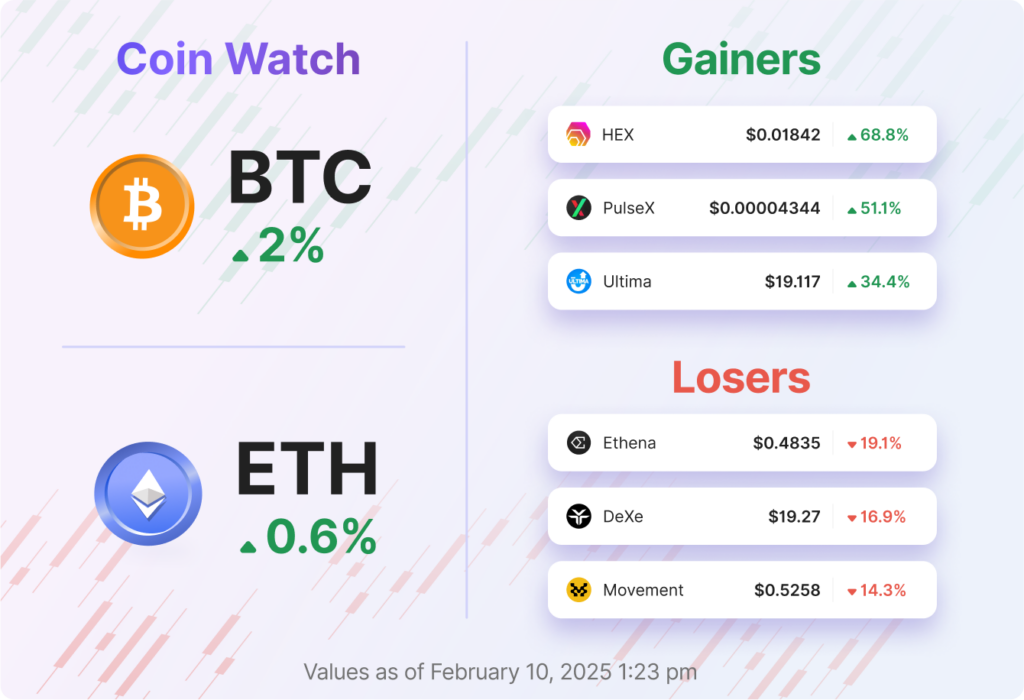The past week has been a whirlwind for crypto, with institutional players doubling down, regulatory landscapes shifting, and new political maneuvers shaping the future of digital assets. From a Bitcoin giant rebranding to crypto playing a role in immigration policies, here’s everything you need to know.

Michael Saylor’s Company Rebrands to ‘Strategy’

MicroStrategy, the company famous for its aggressive Bitcoin investments, has officially rebranded itself as ‘Strategy.’ This move highlights its transition into what it now calls the “world’s first and largest Bitcoin Treasury Company.”
Under the leadership of Michael Saylor, Strategy currently holds a staggering 471,000 BTC worth $45 billion, making it the largest corporate Bitcoin holder. With Bitcoin’s surge to $109K, Strategy’s stock has skyrocketed 565% over the past year, attracting investors who want Bitcoin exposure without directly holding it. The company’s new logo features the Bitcoin “₿” symbol, and its revamped orange branding is meant to represent “energy, intelligence, and Bitcoin itself.”
Strategy’s influence has now extended beyond just the crypto space, as it has recently joined the Nasdaq-100 index. This makes its stock a popular choice for investors looking to gain indirect exposure to Bitcoin’s price movements. Despite reporting a $671 million loss in Q4, its long-term Bitcoin bet continues to strengthen its market position.
Hong Kong Recognizes Bitcoin & Ethereum for Investment Immigration

Hong Kong has taken a massive step toward integrating crypto into its financial system by recognizing Bitcoin and Ethereum as valid proof of wealth for investment immigration applications.
To qualify, applicants must own at least HK$30 million ($3.85 million) in assets and commit to investing the same amount in Hong Kong within six months. Authorities also require that crypto holdings be stored in cold wallets or reputable exchanges like Binance for security reasons.
This policy shift signals Hong Kong’s growing openness toward digital assets, making it one of the few global financial hubs to embrace crypto for immigration purposes. While the government currently only accepts crypto as proof of wealth, it remains unclear whether future applications will allow direct crypto investments or ETFs as part of the required investments.
Trump’s Crypto Main Man Predicts a ‘Golden Age’ for Digital Assets

David Sacks, Trump’s newly appointed crypto leader, is spearheading efforts to establish the U.S. as a dominant force in digital assets. At a recent press conference, Sacks outlined a bold agenda to create a “golden age” for crypto, focusing on clear regulations and investor-friendly policies.
One of the key priorities is stablecoin regulation, with lawmakers drafting bills to define oversight responsibilities between state and federal agencies. Sacks also emphasized Bitcoin’s role as a “first and most secure digital currency,” likening it to digital gold.
The House and Senate are forming a joint working group to draft new laws aimed at keeping crypto businesses in the U.S., rather than losing them to more crypto-friendly jurisdictions. By ensuring regulatory clarity, the administration hopes to attract more investment and innovation within the country.
Elon Musk Exploring Blockchain for U.S. Government Efficiency

Elon Musk, now leading the newly formed Department of Government Efficiency, is exploring ways to integrate blockchain technology into government operations.
His vision includes using blockchain for tracking government spending, securing sensitive data, managing properties, and streamlining payments. This aligns with the Trump administration’s broader goal of embracing blockchain and crypto innovations.
While discussions are still in the early stages, Musk has reportedly been in talks with multiple public blockchain projects. If implemented, this could mark one of the most significant government reforms leveraging blockchain technology.
What’s Next?
This week could be crucial for the crypto market as investors brace for key economic data. On Wednesday, February 12, 2025, the U.S. Bureau of Labor Statistics will release the Consumer Price Index (CPI) data for January, a key indicator of inflation.
If inflation numbers come in high, concerns over potential interest rate hikes could weigh on crypto markets. On the other hand, lower inflation could boost investor confidence, fueling further market gains.
Despite short-term fluctuations, the broader crypto landscape remains strong, with growing institutional interest, improving regulations, and macroeconomic trends working in its favor. Staying informed and focusing on long-term fundamentals will be key to navigating the evolving market.



